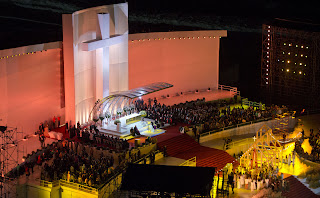 |
| The altar at World Youth Day 2013 |
Profane music more appropriate
to a rock concert and in violation of the rubrics on music,
Dancing
more appropriate to an aerobics class than the liturgy,
Drums
and other rock instruments specifically prohibited by sacred documents on
music,
Solo
singing reminiscent of a cabaret act,
Plastic
cups for distributing the Body of Christ???
Some
of these objections are obviously highly subjective: whether a particular solo
is more appropriate for a “cabaret” than for worship or whether particular
dancing is more appropriate to an aerobics class than for worship. Others are just disinformation: there is no
ban on the use of drums in the Sacred Liturgy.
I
don’t think there is malice on part of the good lady, only ignorance. And this is the problem. I gather from reading her posts and her news
letter over the years that she and I grew up at the same time, I north of the
Mason Dixon and she south. I gather that
we both went to Catholic Schools where we had the good nuns who taught us the
music of the Latin Liturgy (especially Mass 8), and told us about Pope Saint
Pius X and his insistence on the organ being the only instrument for the
liturgy. Pius was reacting to the
orchestra masses of the 18th and 19th century—the Mozart
Coronation Mass for example—in which the congregation was reduced to the state
of an audience while professional singers were required for performance. Pius’ determination to restore chant was
precisely to restore active participation in the Liturgy. Pius’ Liturgical reforms were a tremendous
step forward, but they were not the final step in liturgical development. Now I
am not saying that Pope Saint Pius X would have loved the Copacabana Mass. I am sure he would not have. But like all us mortals, Pius lived in a
fixed period of time which shaped his worldview. The Church is a living organism, as is its
liturgy. It has continued to develop
since the days of the Pope who made such a difference in Catholic devotion with
permission for daily Holy Communion.
Pius’ norms remained in effect for decades but change did come and it
came before Vatican II. First came the
encyclical letter of Pius XII, Mediator
Dei approximately fourteen years before the Council opened. Then came Vatican II and Sacrosanctum Concilium which mandated serious revision of the
Sacred Liturgy (though not perhaps as serious a revision as we were given in
the Missal of Paul VI) and encouraged “inculturation” to permit the liturgy to
be adapted to the various cultures in which the Church finds itself. Sacrosanctum
Concilium was followed by innumerable other documents carrying out the
mandate of the Council that the Liturgy should involve a full, active, and conscious
participation on the part of the laity in the Mass. All sorts of permissions were given and some
permissions were denied. Some
permissions—dance for example—were allowed in certain cultures and banned in
others. The Papal Masses, both in Rome and
when the popes were “on the road” became models for what could be done with the
Liturgy and different cultures used Papal Visits to showcase their unique gifts
and now being worthy of an offering to God. Personally I am delighted that Pope Francis has signaled an end to the attempts at partial restoration of the pre-conciliar rites. His choice to wash the feet of women in the Holy Thursday liturgy was the first clear sign that there is a new sheriff in town. His choice of the simplest of vestments, his insistence on celebrating facing the congregatgion (versus populum as opposed to versus apsidem), his use of the “for all” (as opposed to the “for many”) in vernacular celebrations, and other gestures have been clear signs that we don’t have to worry about the peculiarities of the neo-trads being imposed on us at prayer. I know it upsets the good lady from Woodstock and others of her ilk who thought that they were about to restore the traditions they knew so well but which had begun to fade from pious memory, but it is allowing the rest of us to get on with a serious and focused approach to our faith.
No comments:
Post a Comment